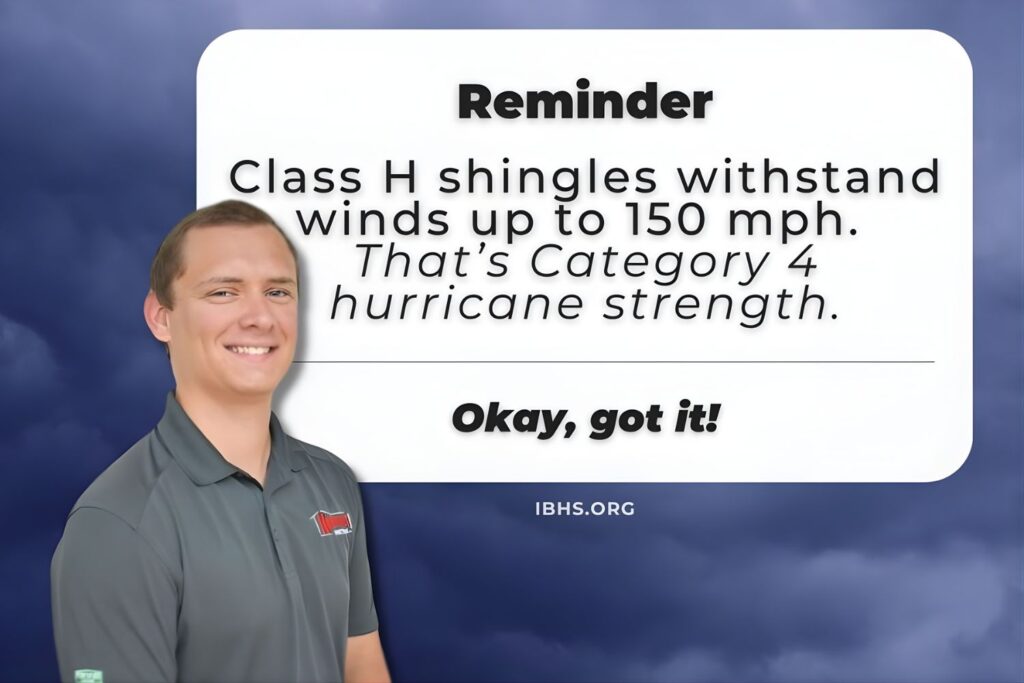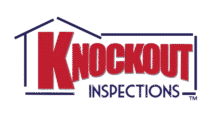This guide breaks down what really matters in roof shingle ratings, clears up common myths, and explains how to make the right choice for your home or roofing project.
Fortified roofing isn’t just a buzzword. It’s a proven system designed to help homes withstand hurricanes, high winds, and hail. This is especially important in states like Florida, Alabama, Louisiana, and Mississippi.
At Knockout, we’ve spent more than a decade guiding homeowners, roofers, and insurance agents through the FORTIFIED process.
But one question comes up again and again: Do I need Class 3 or Class 4 shingles to have a FORTIFIED Roof? The short answer is no. Let’s find out more.
What Does a FORTIFIED Roof Really Mean?
Before comparing shingle types, it helps to understand what “FORTIFIED” actually refers to. The FORTIFIED Roof™ program, developed by the Insurance Institute for Business & Home Safety (IBHS), sets standards that go beyond normal building codes.
A FORTIFIED Roof is built to:
- Keep water out, even if shingles blow away
- Resist wind uplift through better nail patterns and sealed edges
- Strengthen weak points like roof decking and flashing
- Withstand repeated weather events year after year
This system focuses on how the roof is built and sealed, not just which shingles are used. That’s why Class 3 or Class 4 shingles aren’t automatically required; they’re only part of the bigger picture.
The Core Requirements: Wind Resistance First
FORTIFIED Roof standards are based primarily on wind performance, not hail impact. The main goal is to prevent shingles from detaching during strong winds or hurricanes.
To qualify for FORTIFIED Roof certification, the shingle must meet these ratings and requirements:
- Class F (110 mph) or Class H (150 mph) wind ratings
- Manufacturer-approved installation with the correct nailing pattern (often six nails per shingle)
- Properly sealed roof decks and underlayment
These features work together to lock down the roof edges and keep wind from peeling up shingles.
If your shingles meet those wind standards and your installation passes inspection, your roof can achieve a FORTIFIED designation even without impact-rated materials.

Understanding Roof Shingle Impact Ratings
Shingles are also rated for impact resistance through a separate test, UL 2218, which measures how well they hold up against hail.
Here’s how the classes break down:
| Class | Test Method | Hail Size Resistance |
| Class 1 | Steel ball ~1.25 inches | Small hail |
| Class 2 | Steel ball ~1.5 inches | Moderate hail |
| Class 3 | Steel ball ~1.75 inches | Large hail |
| Class 4 | Steel ball ~2 inches | Severe hail |
Class 4 shingles are the strongest option for hail protection, and some insurance companies offer discounts for homes that use them. However, these shingles are not required for a FORTIFIED Roof unless you opt for the Hail Supplement.
The Hail Supplement
In hail-prone areas, you can choose to upgrade your FORTIFIED Roof with the Hail Supplement.
This add-on includes Class 3 or Class 4 shingles and gives your roof extra protection where hailstorms are frequent. It may also make you eligible for additional insurance discounts.
Benefits of Adding the Hail Supplement
- Better protection from hail dents and cracks
- Extended shingle lifespan
- Lower long-term repair costs
- Possible insurance savings
If you live in a hail-heavy region like Alabama or Mississippi, Knockout Inspections can help you evaluate whether this upgrade is worth the investment.
Common FORTIFIED Roof Misconceptions
Because roofing standards vary from one region to another, there’s a lot of confusion about what FORTIFIED certification really requires. Here are three misconceptions we encounter most often:
Myth 1: You must have Class 4 shingles to get FORTIFIED.
False. Wind-rated shingles that meet Class F or Class H standards can still qualify. The focus is on installation quality, not shingle type.
Myth 2: All insurance discounts require Class 4 shingles.
Not true. Many policies reward FORTIFIED wind protection separately from hail discounts. The savings depend on your insurer and your roof type.
Myth 3: FORTIFIED is only for new roofs.
Incorrect. Existing roofs can often be upgraded to meet FORTIFIED standards when reroofing, as long as the proper sealing and nailing methods are used.
Why Roofers Often Get Confused
FORTIFIED roofing can be complex, especially for contractors new to the process. Misunderstandings spread quickly, and it’s easy to see why many assume Class 4 shingles are required.
Here’s why confusion happens:
- Insurance overlap: Some insurance agents combine hail and wind programs in their recommendations, leading homeowners to think that Class 4 is always necessary.
- Manufacturer marketing: Shingle companies advertise their products as “FORTIFIED-ready,” which can make it sound like they’re required, even when they’re not.
- Peer misinformation: Roofers often share what they’ve heard in online forums or training sessions, and one mistaken claim can spread fast.
Knockout’s team helps minimize confusion by working directly with roofers and builders before installation begins. We verify that every project meets the real IBHS standards and provide feedback that ensures certification the first time.
How Knockout Supports Homeowners
Homeowners often hear mixed messages when trying to decide which shingles to buy. The key is understanding your specific risks and goals.
If you live in a coastal or hurricane-prone area, focus on wind resistance first. A Class H shingle with proper installation will usually meet FORTIFIED standards.
If you’re in a region with frequent hailstorms, impact-rated shingles could be a smart upgrade, even though they aren’t required.
What Knockout helps you determine:
- Which shingle class meets your area’s FORTIFIED criteria
- Whether impact protection is worth the extra cost
- How to document your installation for insurance and certification purposes
Our evaluators help you make cost-effective choices that keep your home safer without paying for unnecessary upgrades.

How Knockout Helps Roofers and Contractors
For roofers, the FORTIFIED program can be a major selling point if it’s done correctly.
Here’s how to make sure every job passes inspection:
- Match shingle wind ratings to your project’s wind zone
- Follow the six-nail pattern and the manufacturer’s instructions exactly
- Use sealed roof decks and locked drip edges
- Partner with a certified FORTIFIED evaluator before starting the project
Knockout Inspections regularly works with contractors to prevent failed evaluations. When installers understand both the requirements and the documentation needed, everyone wins: the roofer, the homeowner, and the insurer.
Frequently Asked Questions
Can I get FORTIFIED certification with regular shingles?
Yes. As long as your roof shingle type meets the required wind ratings and is installed correctly, you can qualify.
Are Class 4 shingles worth the investment?
In hail-prone areas, yes. They can reduce impact damage and may lower insurance costs. In purely coastal zones, wind-rated shingles are usually enough.
Can metal roofs qualify for FORTIFIED?
Yes. Metal, asphalt, and other roofing materials can all meet FORTIFIED standards if properly installed and evaluated.
Can Knockout work directly with my roofer?
Absolutely. We coordinate with contractors to confirm that all documentation, photo evidence, and installation details meet FORTIFIED requirements before submission.
The Knockout Advantage
Knockout Inspections isn’t just another evaluator. It’s a partner in the roofing process.
Here’s what sets us apart:
- Step-by-step support from planning through certification
- Detailed photo documentation and inspection reports
- Official IBHS submission handled by our team
- Coordination with both roofers and insurance agents
- Ongoing renewal support every five years
With over a decade of hands-on experience, our team understands both the technical side of roofing and the communication side that keeps everyone aligned.
Why This Information Matters
Understanding shingle ratings can save thousands of dollars and prevent project delays. The FORTIFIED program exists to protect homes, not complicate construction.
If you take away one message from this guide, it should be this:
You don’t need Class 3 or Class 4 shingles to have a FORTIFIED Roof.
You just need properly rated materials installed to the correct standard.
At Knockout Inspections, we’re here to make that process simple, transparent, and accurate. Whether you’re upgrading a roof, building a new home, or guiding clients through insurance requirements, we help you meet the standards that truly matter.
Conclusion
A strong roof starts with the right knowledge about shingle ratings. By understanding the difference between wind and impact ratings, you can choose materials that match your region’s risks and budget.
If hail protection is important, consider the Hail Supplement. If you’re focused on wind resilience, a properly installed Class H shingle system may be all you need.
When you’re ready to begin, reach out to Knockout Inspections. Our certified FORTIFIED evaluators are ready to help you build, inspect, and certify a roof that stands up to whatever nature throws your way.

